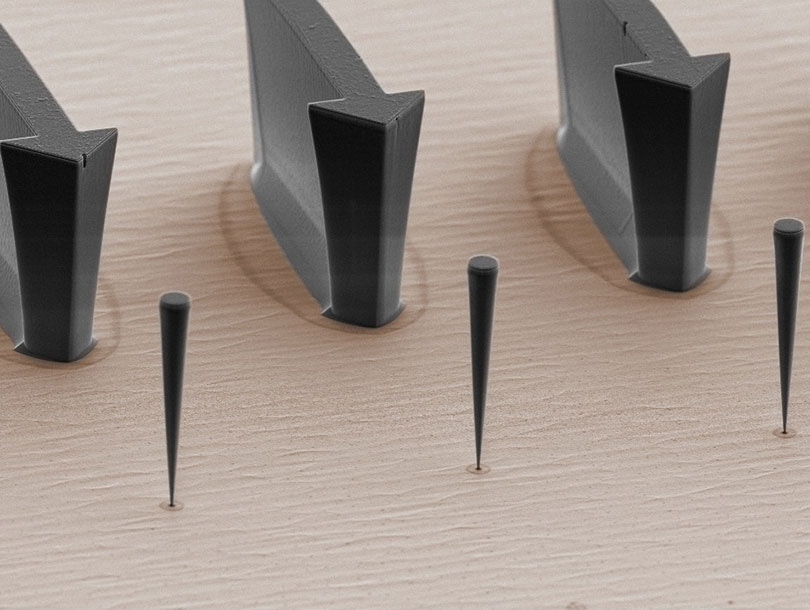Jul 18 2017
Scientists from the Swiss Nanoscience Institute and the University of Basel have carried out successive coupling of an extremely tiny quantum dot with a trumpet-shaped nanowire that is 1,000 times larger.
 Trumpet-shaped nanowires with a length of about 10 micrometers are coupled to quantum dots located at their bases. The movement of the nanowire can be detected with a sensitivity of 100 femtometers by changing the wavelength of the light emitted by the quantum dots. The arrows are important for fabrication and help to locate the nanowires. © Grenoble Alps University
Trumpet-shaped nanowires with a length of about 10 micrometers are coupled to quantum dots located at their bases. The movement of the nanowire can be detected with a sensitivity of 100 femtometers by changing the wavelength of the light emitted by the quantum dots. The arrows are important for fabrication and help to locate the nanowires. © Grenoble Alps University
It is possible to detect the movement of the nanowire with a sensitivity of 100 femtometers through the wavelength of the light released by the quantum dot. On the contrary, the oscillation of the nanowire can be impacted by excitation of the quantum dot with a laser. The results have been published in Nature Communications.
Professor Richard Warburton and Argovia Professor Martino Poggio’s teams in the Department of Physics and the Swiss Nanoscience Institute at the University of Basel collaborated with colleagues from Grenoble Alps University and the Alternative Energies and Atomic Energy Commission (CEA) in Grenoble in order to couple a microscopic mechanical resonator with a nano-scale quantum dot.
The Researchers used nanowires produced from gallium arsenide that have a diameter of a few micrometers at the top and are about 10 μm long. The wires resemble that of small trumpets arranged on the substrate since they taper sharply downwards. The Researchers placed a single quantum dot, capable of emitting individual light particles (photons), close to the base, which is just about 200 nm wide.
Excitations lead to strains
If the nanowire oscillates back and forth because of electrical or thermal excitation, the comparatively large mass at the wide end of the nano-trumpet generates large strains in the wire that indeed affect the quantum dot at the base. The squeezing together and pulling apart of the quantum dots result in a change in the wavelength and thus the color of the photons released by the quantum dot. Despite the fact that the changes are not specifically large, sensitive microscopes with extremely stable lasers – exclusively developed in Basel for such measurements – have the potential to detect the wavelength changes in a precise manner.
The shifted wavelengths can be used by the team to identify the motion of the wire with a sensitivity of just 100 fm. The Researchers expect to increase or decrease the oscillation of the nanowire by exciting the quantum dot with a laser.
Prospective uses in sensor and information technology
We are particularly fascinated by the fact that a link between objects of such different sizes is possible.
Professor Richard Warburton
There are also different promising applications for this mutual coupling.
“For example, we can use these coupled nanowires as sensitive sensors to analyze electrical or magnetic fields,” explains Poggio, who is exploring the possible applications with his team. “It may also be possible to place several quantum dots on the nanowire, to use the motion to link them together and so pass on quantum information,” adds Warburton, whose team concentrates on the diverse applications of quantum dots in photonics.
Artificial atoms with unique properties
Quantum dots, referred to as nanocrystals, are also called artificial atoms since they behave in the same way to atoms. They are majorly bigger than actual atoms as they have a typical extent of 10 to 100 nm. Their shape, size and also the number of electrons can differ. There is also a major limitation on the electrons’ freedom of movement in the quantum dots, and the resulting quantum effects provide them with extremely special electrical, magnetic and optical properties. For instance, quantum dots are capable of emitting separate light particles (photons) after excitation, which can then be spotted with the help of a tailor-made laser microscope.